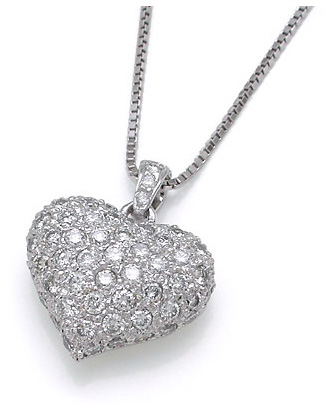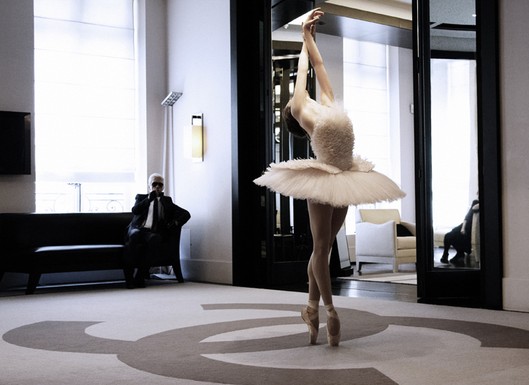The Hohles Fels Venus is interpreted as being hung as a pendant from a string or rope (Conard: 2009). It is completely possible that this Venus was a form of jewelry; it would likely be given to someone important in the life of the maker. If the Venus was made by a man, he would have likely given it to a wife (if he had one) or daughter. Jewelry seems to be a commonality of all modern day cultures, and it is highly plausible that the same was true in the past.
 |
| http://www.sndgems.com/platinumdiamondhearts.htm |
The Venus of Willendorf as well as the Venus of Brassempouy are interpreted as having worn head gear (Soffer et al.: 2000, Stockstad and Cothren: 2011). Maybe some form of headgear was required to keep warm during the Upper Paleolithic period. The engraved heads of the Venuses may just be showing the fact that women wore beanies to help fight the cold. Even though the Willendorf Venus appears to be naked besides for her headdress, the creator seems to have wanted to express her as having worn a crown or something similar.
 |
| http://howtobecomeastylist.com/2011/02/wear-beanie/ |
The Venus of Dolni Vestonice and Venus of Willendorf are similar in that they both have exaggerated female characteristics (Stockstad and Cothren: 2011). This may be similar to our modern day dolls which also exaggerate the female body. Barbie dolls for example have highly distorted proportions with an extremely thin waste, long legs and a large bust. In turn, The Barbie dolls may be interpreted as representing the ideal image of a woman. This image of the ideal has been disdained by some who say that the dolls are influencing young girls into wanting to look like the dolls (Norton et al: 2006). Venus figurines are the exact opposite as far as proportions from Barbie dolls. But it is possible that the people who made the figurines felt that they were creating the ideal woman in stone. Young women may have been influenced to look like the figurines just like modern day women are influenced to look like Barbie dolls. This influence may have been positive or negative but it is important to say that the figures may have been controversial just like how Barbie dolls are today.
 |
| http://www.last.fm/music/Barbie |
The Venus of Galgenburg is interpreted to be dancing (Bahn: 1989). I can see why Bahn feels this way even though the interpretation that the figurine is a woman is established on a very rough looking piece of art. This Venus does not seem to have much detail in it when compared to other Venuses but I feel that categorizing it as a Venus that is dancing is still plausible. By being so different, but still similar, you have to look at this Venus through a slightly different lens. Bahn did look through his own lens thus creating a highly elaborate story behind this figurine.
 |
| http://www.wwd.com/eye/people/famed-ballerina-dances-for-lagerfeld-2146848 |
Venus figurines are highly variable in size, shape and construction and because of this it is hard to generalize any overarching conclusion about them. Many have tried though, with some coming up with highly sexualized interpretations of the figurines. This type of interpretation has now been refuted, especially by newer generations of Anthropologists. I only site a few Venus figurines in my blog, but even while only looking at a few, you can tell that they are all unique in their own ways. Along the same vein, our interpretations about their symbolism are also variable and fluctuating. I hope that the pictures I provided give food for thought and that they make you come up with some of your own conclusions about the Venus Figurines!
Works Cited:
Bahn, Paul G. “Age and the female form.” Nature 342 (1989): 345-346. Web. 30 Oct. 2012.
doi:10.1038/342345a0
Conard, Nicholas J. “A female figurine from the basal Aurignacian of Hohle Fels Cave in southwestern Germany.” Nature 459 (2009): 248-252. Web. 30 Oct. 2012.
Norton, Kevin I. et al. “Ken and Barbie at Life Size.” Sex Roles. Vol. 34 (2006): 287-294. Web. 7 Nov. 2012
Soffer, O., Adovasio J. M., and Hyland D.C. “The ‘Venus’ Figurines: Textiles, Basketry, Gender, and Status in the Upper Paleolithic.” Current Anthropology Vol. 41 No. 4 (August/October 2000): 511-537. Web. 30 Oct. 2012. http://www.jstor.org/stable/10.1086/317381
Stokstad, Marilyn, and Cothren, Michael W. Art History. 4th ed. Boston: Pearson, 2011. Print.
No comments:
Post a Comment